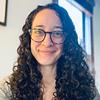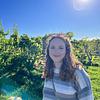Take a photo of a barcode or cover
adventurous
dark
emotional
reflective
sad
tense
medium-paced
Plot or Character Driven:
A mix
Strong character development:
Yes
Loveable characters:
Yes
Diverse cast of characters:
Yes
Flaws of characters a main focus:
No
adventurous
challenging
dark
emotional
reflective
sad
tense
medium-paced
Plot or Character Driven:
A mix
Strong character development:
Yes
Loveable characters:
Yes
Diverse cast of characters:
Yes
Flaws of characters a main focus:
Complicated
A young girl's father passes and the family moves to Syria. But, as we all know, Syria is under significant duress right now. Her story is weaved with a myth/legend/story about a girl named Rawiyna from the 1000/1100 CE. Good book - slow to start, but got better. Also - a great description of being a refugee
I think I would have enjoyed this more if I would have read a hard copy instead of listening to audio. The switch between storyline felt choppy in audio.
Adventure tale woven in with a modern refugee/immigrant experience. So many go through so much simply for the right to food and shelter.
Rich, engaging interweaving of heroic legend with harrowing refugee story. I loved the setting - I learned a lot! Also enjoyed the synesthesia - could've been even more!! Recent "historical" fiction was fantastic perspective. I had to pay attention to know which storyline I was in (ear reading so couldn't see section breaks... but also a lot going on this time of year!) and some gaps that made a bit disjointed/ambiguous but enough of a thread was laid to wrap story into a complete package.
Interesting companion to The Last Mapmaker (Cristina Soontornvat)... would be cool leveled reading study.
Interesting companion to The Last Mapmaker (Cristina Soontornvat)... would be cool leveled reading study.
This novel tells the dual or parallel stories of Nour and Rawiya, young women who follow identical paths through the middle east and northern Africa to Europe, separated by 800 years.
Rawiya's tale is set in the 13th century, and is a mythic, cultural story Nour has grown up with. So while we're reading about Rawiya, we know Nour has done so too. Rawiya is a young girl whose father has died; she longs for adventure and wants to help her mother by seeking her fortune. She disguises herself as a boy named Rami, and becomes an apprentice to al-Idrisi, a man traveling the middle east, Africa and Europe to create the greatest map ever made for his friend King Roger of Sicily. Rami/Rawiya becomes a sort of superhero figure, able to wield knives with great speed and accuracy, run through fire, be unseen by enemies, and defeat bird-monsters.
I enjoyed the tale of Rami/Rawiya, though I would identify its genre as historical fantasy or superhero story, and I'm not always a fan of that. I AM a fan of all medieval history, so I liked the settings and the word pictures the writer drew of the medieval cities, great castles and jewels that appear in the story. It was a story of adventure, battles, losses and wins - great fun but at the same time less compelling than Nour's story. I wasn't really drawn into it.
Nour's story is set in the present day. Nour is the youngest daughter in a Syrian family living in New York City, and Nour in fact was born in NYC. As the book opens, her father has died and her mother decides to move back to Syria where she can have family around her. Nour has to deal not only with her grief about her dad, but a huge life upheaval, and even as she's adjusting to the move, soon after, the war in Syria comes to their neighborhood. An important piece of background info is that Nour's mom is a cartographer who makes specialized, hand-painted maps, and as the war starts affecting their day to day lives, her mom paints a special map and makes Nour familiar with it. Nour has synesthesia, an ability that makes her see colors in connection with voices, sounds and music; she has a synesthesia alphabet that's significant in connection with the map. A mild critique - I felt there was a lot of meandering off into the world of synesthesia, and I found it distracting from the larger story.
After the bombs fall, Nour, her two sisters, her mom and their family friend embark on a refugee journey that will take them from Syria to Jordan and Egypt, and on a terrifying ferry ride. Nour's sister is injured and some of the family members are separated from one another, but Nour's mom has given her the map and Nour figures out she needs to get to the town of Ceuta in Spain to reach safety at her uncle's home; she hopes she'll be reunited with the rest of her family there. There are more terrifying journeys across the whole of northern Africa, and a big question about whether they will reach Spain alive.
The key is that the two girls, Rawiya and Nour, are on identical paths; Nour has grown up reading about Rawiya and is inspired by her. Whether Nour is a superhero or not is something you can decide after reading. Nour's story, more than Rawiya's, is a real nail-biter and I had to go through all kinds of shenanigans with myself, to keep from reading ahead!
In addition to being compelling and well written, the novel illuminates the refugee's journey and allows us to see what someone like Nour might experience. I work in social services and when we talk about "trauma informed care," we might be talking about someone like Nour who experiences things I am sure I would not survive, mentally and physically. In this story she's headed for Spain, but she could have headed back to the US, perhaps. I think many Americans hear "refugee" and they don't fully comprehend what it means. These people didn't choose to leave their homes in Syria because they couldn't buy perfume. They were bombed. They had no homes left, no clothing, no food. They survived things most of us only see in movies or read about in books.
There's a lot of metaphor and symbolism in this novel - about colors, maps, stars, and water. It's all very interesting and nicely done.
Rawiya's tale is set in the 13th century, and is a mythic, cultural story Nour has grown up with. So while we're reading about Rawiya, we know Nour has done so too. Rawiya is a young girl whose father has died; she longs for adventure and wants to help her mother by seeking her fortune. She disguises herself as a boy named Rami, and becomes an apprentice to al-Idrisi, a man traveling the middle east, Africa and Europe to create the greatest map ever made for his friend King Roger of Sicily. Rami/Rawiya becomes a sort of superhero figure, able to wield knives with great speed and accuracy, run through fire, be unseen by enemies, and defeat bird-monsters.
I enjoyed the tale of Rami/Rawiya, though I would identify its genre as historical fantasy or superhero story, and I'm not always a fan of that. I AM a fan of all medieval history, so I liked the settings and the word pictures the writer drew of the medieval cities, great castles and jewels that appear in the story. It was a story of adventure, battles, losses and wins - great fun but at the same time less compelling than Nour's story. I wasn't really drawn into it.
Nour's story is set in the present day. Nour is the youngest daughter in a Syrian family living in New York City, and Nour in fact was born in NYC. As the book opens, her father has died and her mother decides to move back to Syria where she can have family around her. Nour has to deal not only with her grief about her dad, but a huge life upheaval, and even as she's adjusting to the move, soon after, the war in Syria comes to their neighborhood. An important piece of background info is that Nour's mom is a cartographer who makes specialized, hand-painted maps, and as the war starts affecting their day to day lives, her mom paints a special map and makes Nour familiar with it. Nour has synesthesia, an ability that makes her see colors in connection with voices, sounds and music; she has a synesthesia alphabet that's significant in connection with the map. A mild critique - I felt there was a lot of meandering off into the world of synesthesia, and I found it distracting from the larger story.
After the bombs fall, Nour, her two sisters, her mom and their family friend embark on a refugee journey that will take them from Syria to Jordan and Egypt, and on a terrifying ferry ride. Nour's sister is injured and some of the family members are separated from one another, but Nour's mom has given her the map and Nour figures out she needs to get to the town of Ceuta in Spain to reach safety at her uncle's home; she hopes she'll be reunited with the rest of her family there. There are more terrifying journeys across the whole of northern Africa, and a big question about whether they will reach Spain alive.
The key is that the two girls, Rawiya and Nour, are on identical paths; Nour has grown up reading about Rawiya and is inspired by her. Whether Nour is a superhero or not is something you can decide after reading. Nour's story, more than Rawiya's, is a real nail-biter and I had to go through all kinds of shenanigans with myself, to keep from reading ahead!
In addition to being compelling and well written, the novel illuminates the refugee's journey and allows us to see what someone like Nour might experience. I work in social services and when we talk about "trauma informed care," we might be talking about someone like Nour who experiences things I am sure I would not survive, mentally and physically. In this story she's headed for Spain, but she could have headed back to the US, perhaps. I think many Americans hear "refugee" and they don't fully comprehend what it means. These people didn't choose to leave their homes in Syria because they couldn't buy perfume. They were bombed. They had no homes left, no clothing, no food. They survived things most of us only see in movies or read about in books.
There's a lot of metaphor and symbolism in this novel - about colors, maps, stars, and water. It's all very interesting and nicely done.
I throughly enjoyed this lyrical journey through both the ancient and modern-day Middle East. Not only a story within a story, but also a poetry collection within a novel, and one I couldn’t put down. Nour, a 12 year old Manhattanite transplanted to the land of her family in Homs, Syria, uses an adventure story about a mapmaker’s assistant to make sense of her own family’s voyage into the unknown as refugees. Moving, important, relevant, and I think, a point of entry for me for further reading on Middle Eastern history and literature. Though marketed as literary fiction, I think most readers could handle this one!
I think this is more of a 3.5 star rating, although I do so appreciate the interplay of the stories through the book—one ancient traveler who chooses to leave, one who is ripped from her many homes, again and again. It buoys this dark story of real-and-present horrors and loss occurring everywhere.





